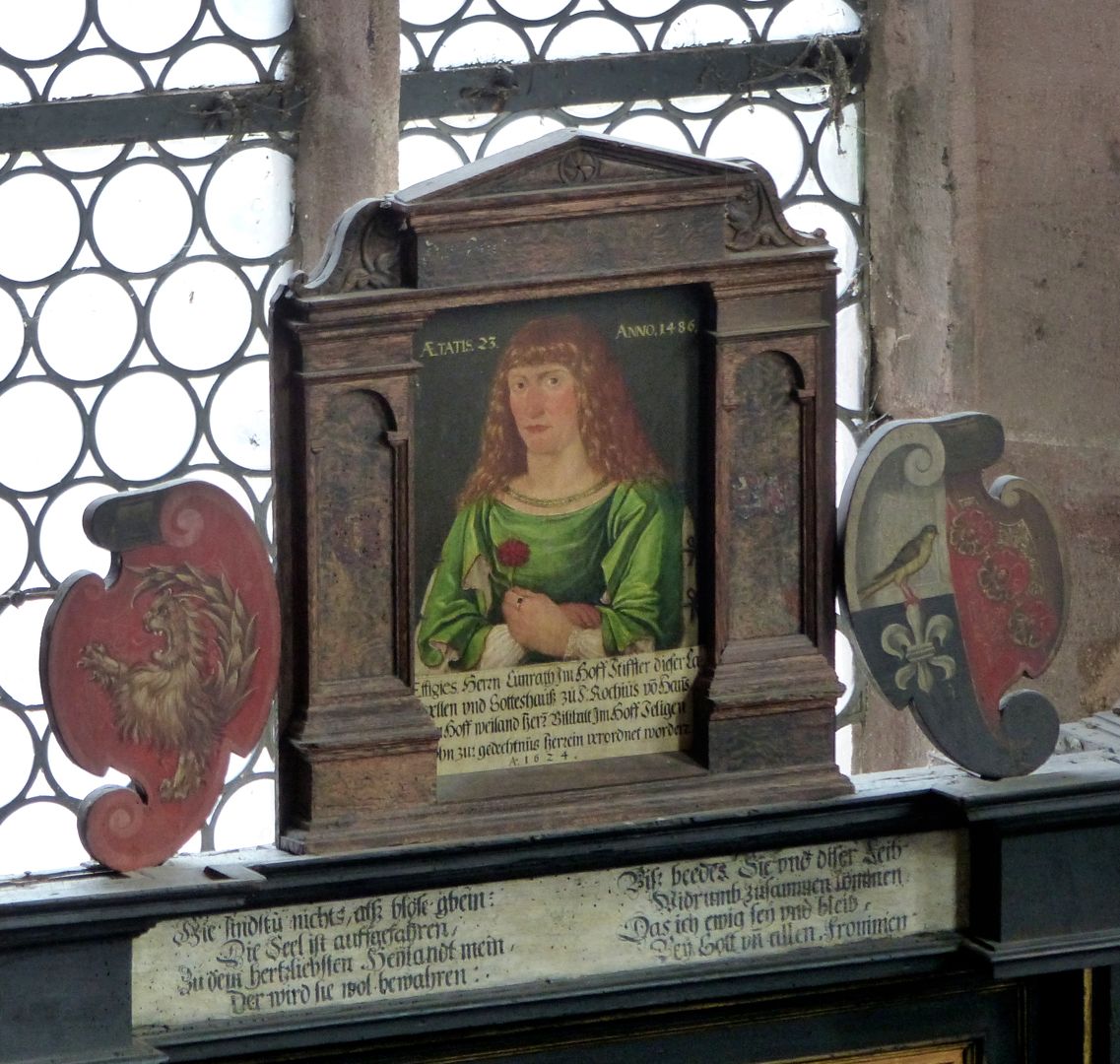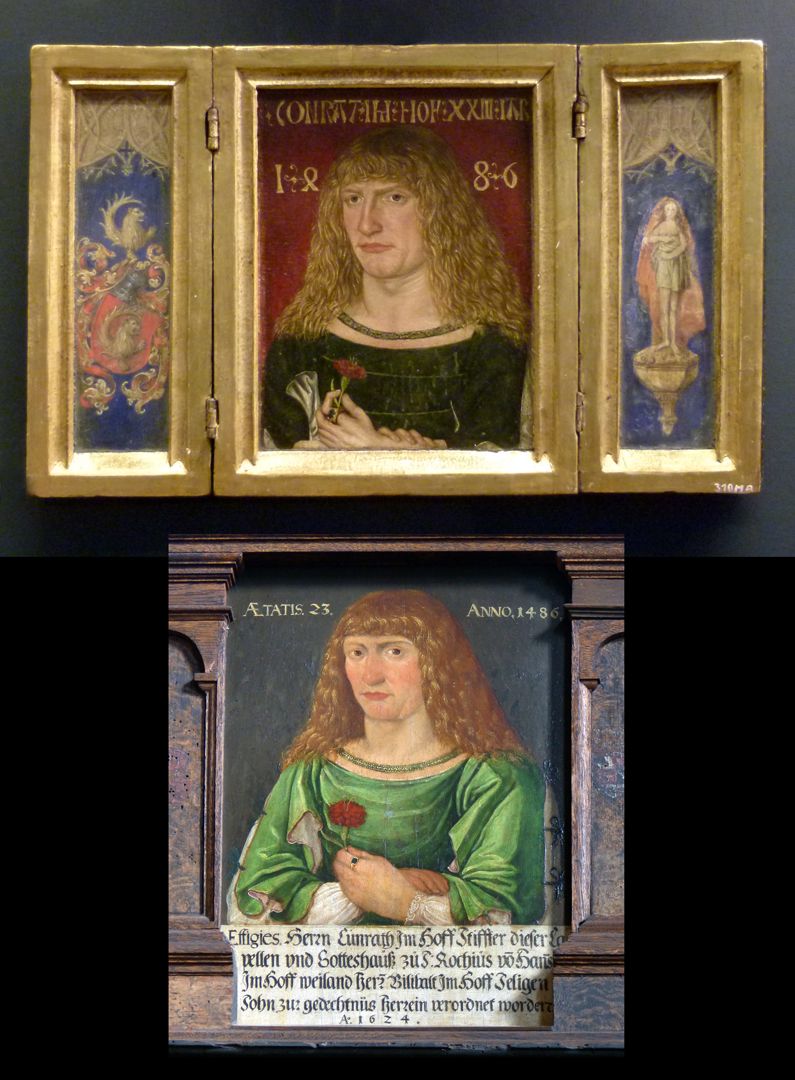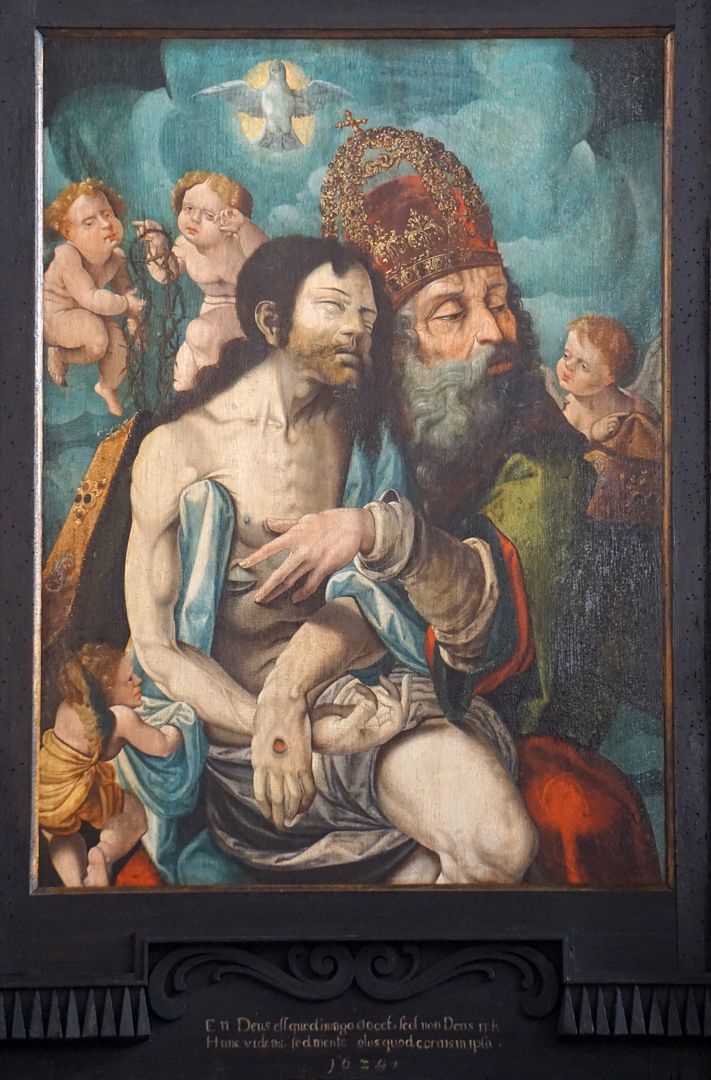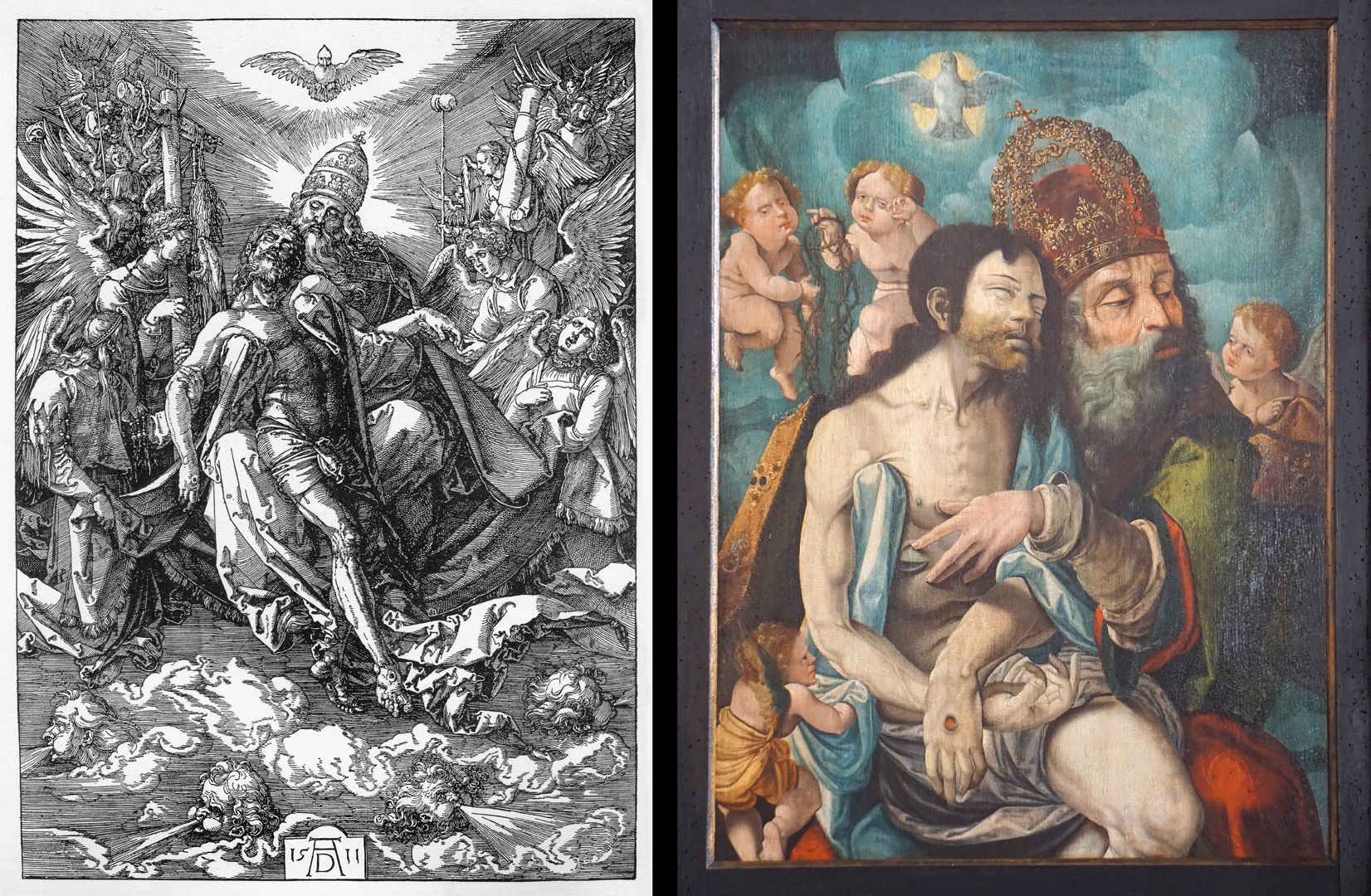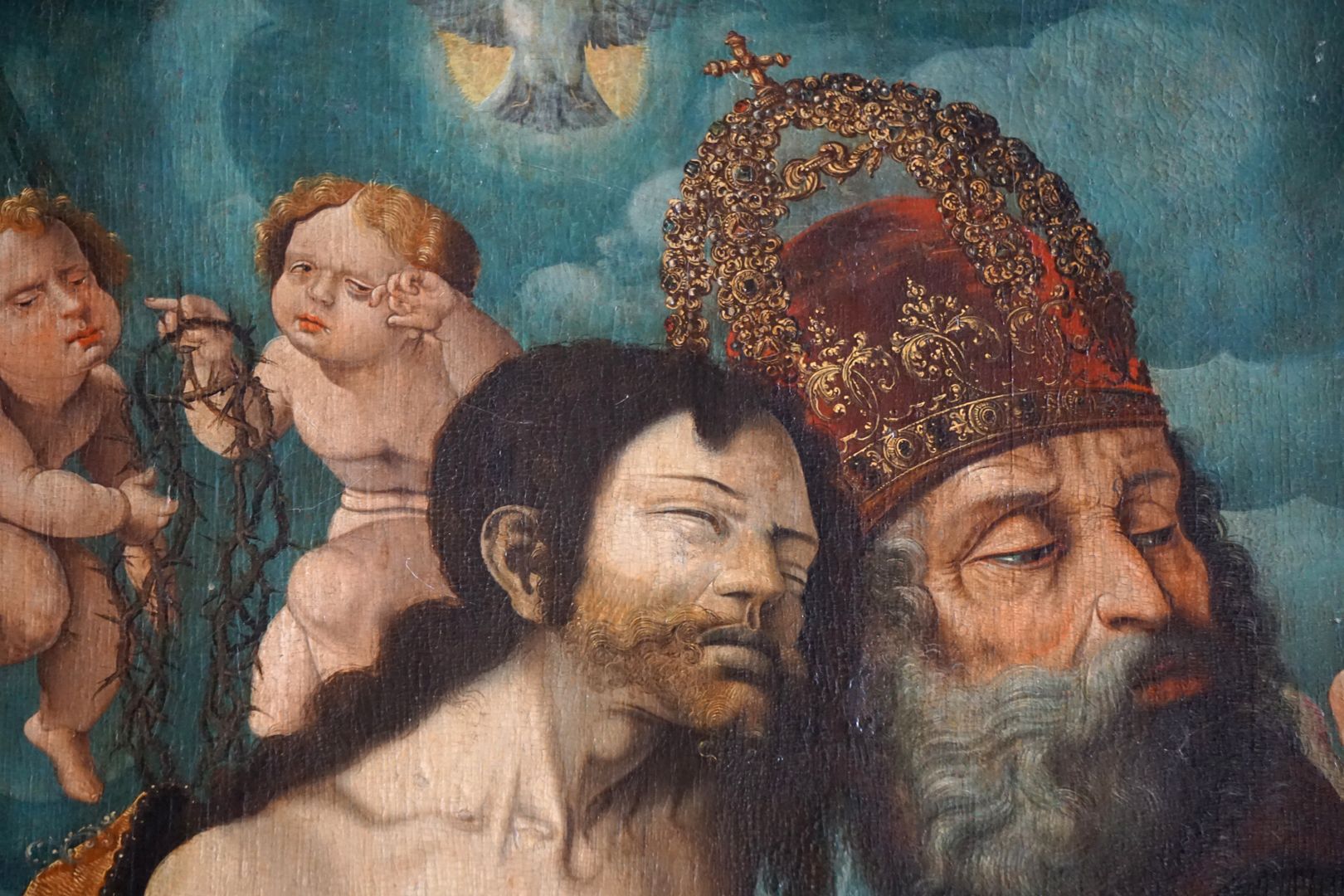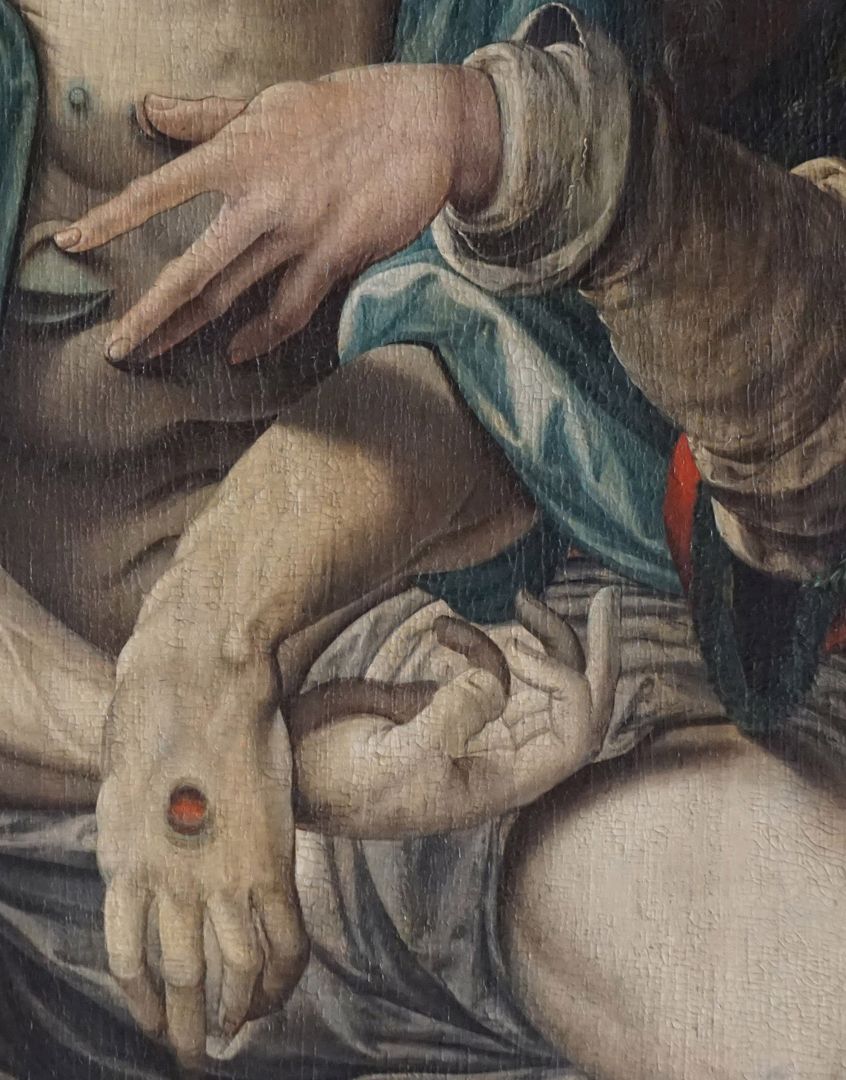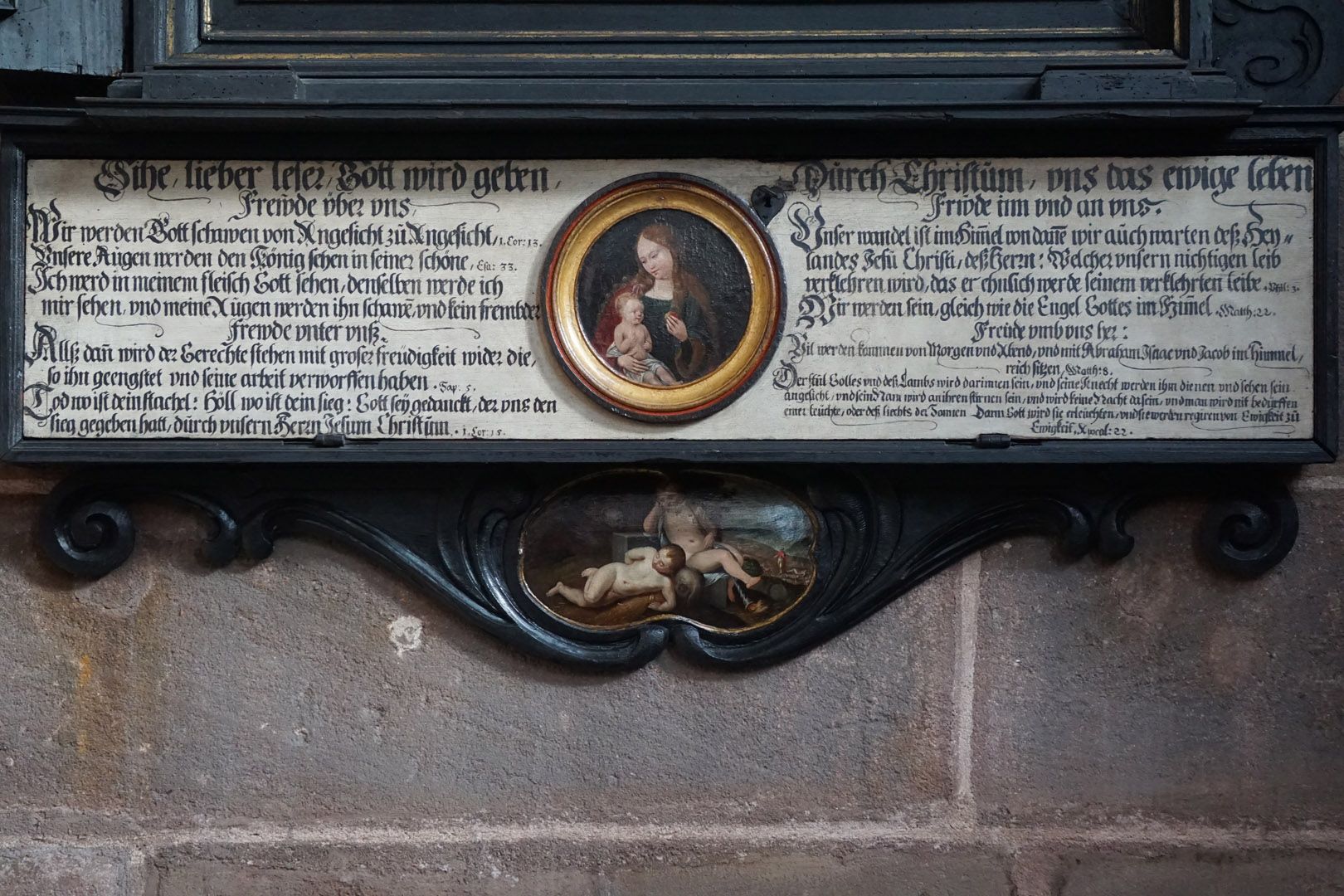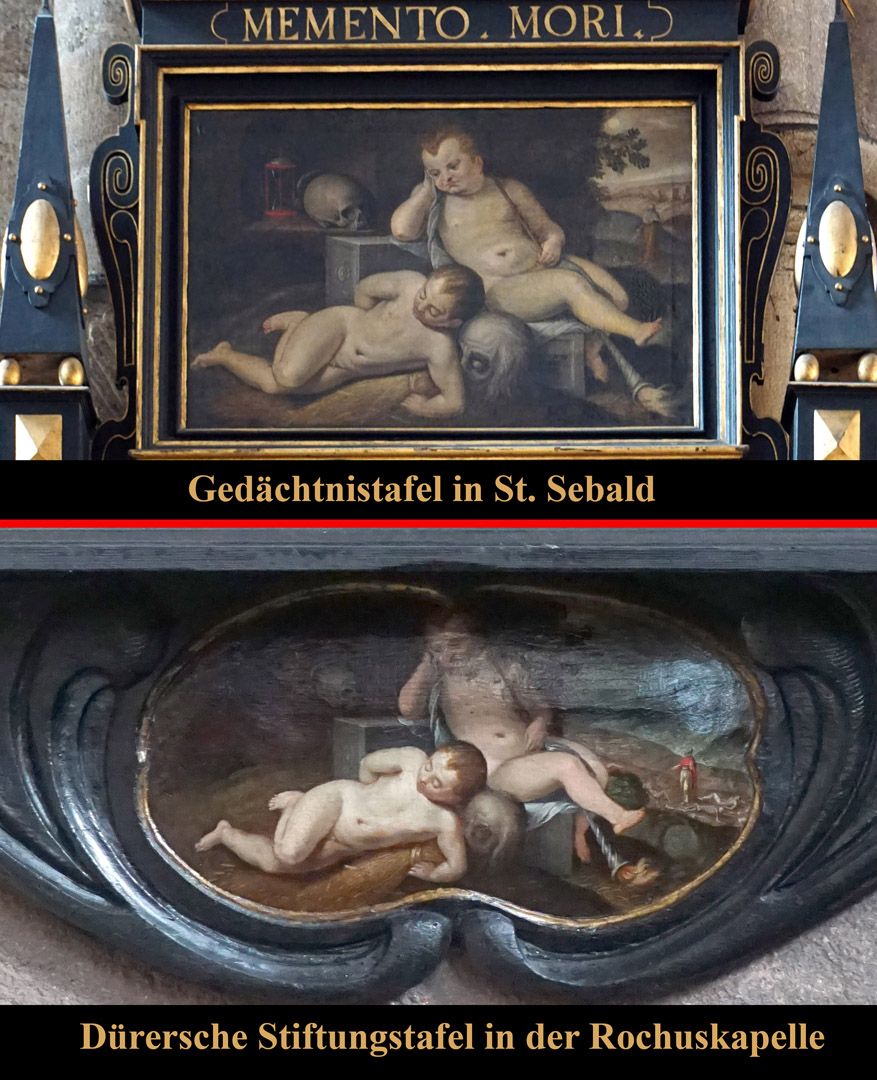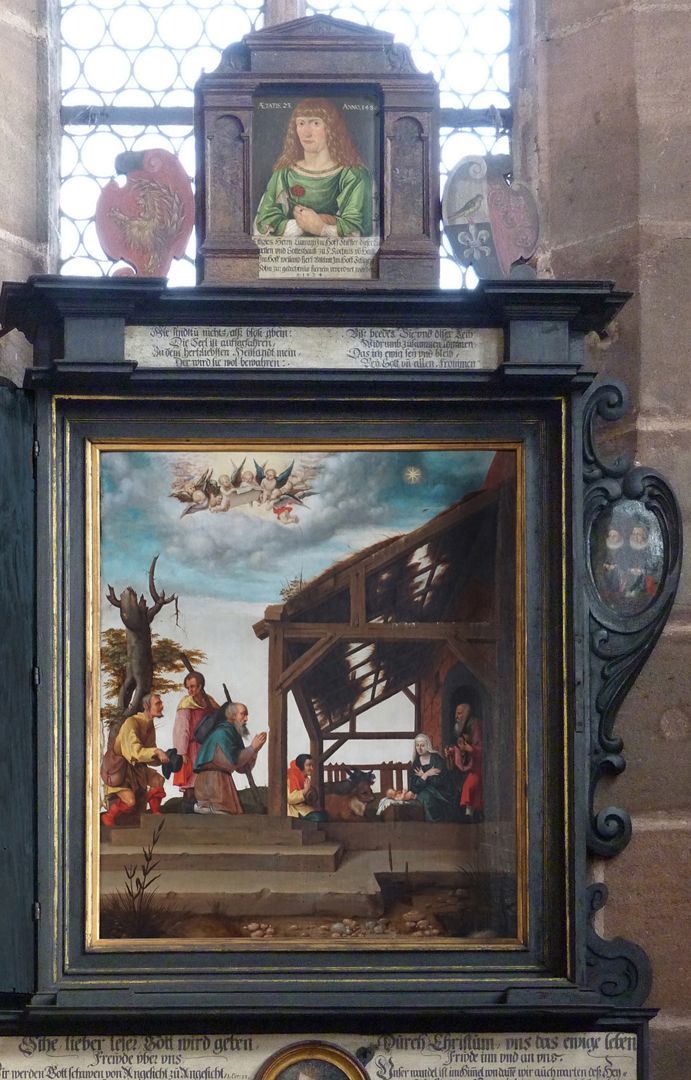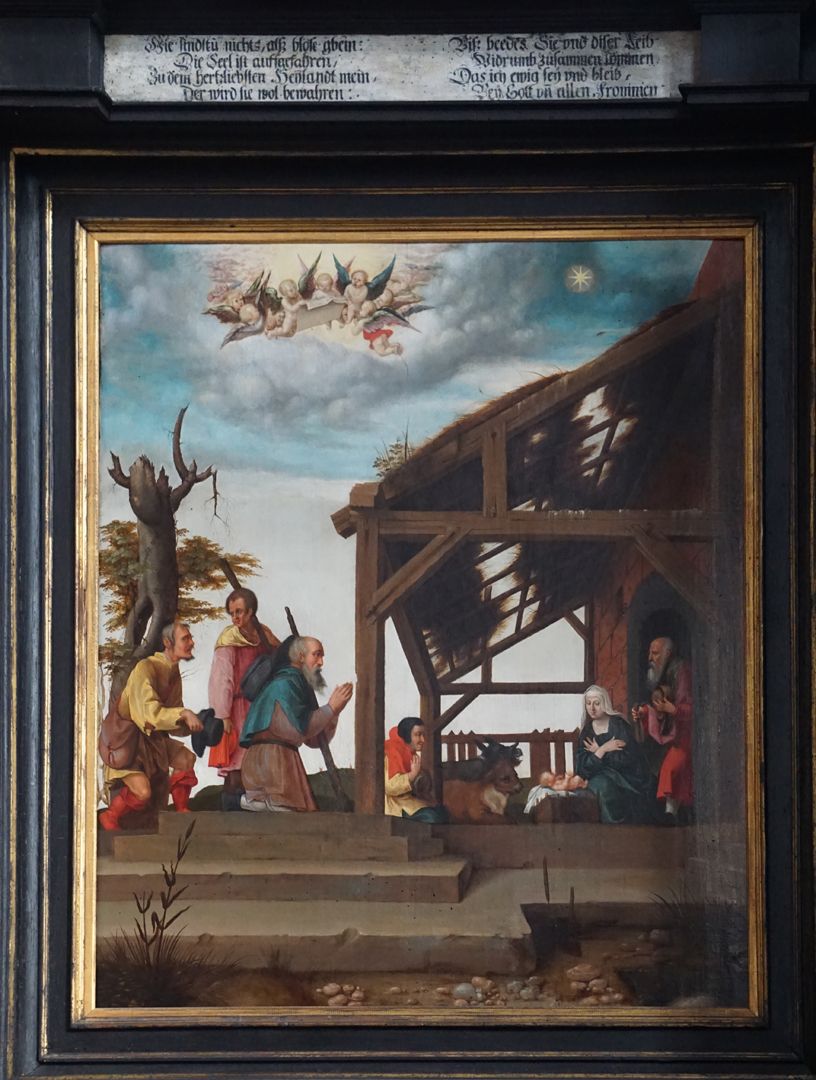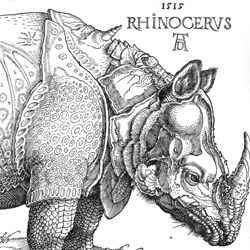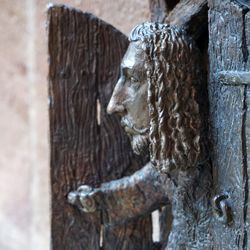Dürer's foundation plaque
Dürer's foundation plaque
1624
View into the choir of the Rochus Chapel, foundation plaque directly north of the main altar
The so-called Imhoff or Dürer foundation plaque from 1624 hangs in the choir directly north of the main altar. It is a flat “cupboard” with a folding panel. For a long time, the work was considered the chapel's ultimate celebrity because it supposedly contained two pictures by Dürer - even Goethe admired them in 1797 without knowing that they were copies. But it's even more serious: not even this property as a "copy" can be proven today. The object is also an epitaph for the art collector Hans VII Imhoff, his father Willibald I and his ancestors Imhoff and Pirckheimer. Georg Gärtner the Younger was the painter here. The solid back wall shows an adoration of the Christ child by the shepherds. The inside of the folding panel depicts the death in 1504 of Creszentia Pirckheimer, wife of the famous humanist, this time with the mentioned year of death and again with Dürer's monogram, although the great master had no business here. When closed, you can see what is perhaps the most interesting of the three paintings: a “mercy seat”, which is ultimately said to go back to Dürer's woodcut of the same name from 1511, paraphrasing it freely. Iconographically, it is striking that Dürer's papal tiara of God has certainly become an imperial crown for religious reasons. Furthermore, there is little correspondence with the model, as a whole and in detail, let alone the painting style. Above the flat cabinet there is an aedicula-like panel with the portrait of the chapel founder Konrad Imhoff, as we know him from the depiction on the triptych by Jakob Elsner dated 1486 (today in the Bavarian National Museum in Munich), i.e. a copy of a late Gothic work. (Pablo de la Riestra) Rochuskapelle Nuremberg, 32 pages, 66 illustrations, format 13.6 x 19 cm, 1st edition 2021, Art publisher Josef Fink / ISBN 978-3-95976-339-4Feedback gebenSeitenleisten
Location: Nuremberg, Rochus Chapel
Design: Dürer, Rezeption, Gärtner (Gertner, Hortulanus), Georg (Jörg) d. J.
Realization: Gärtner (Gertner, Hortulanus), Georg (Jörg) d. J.
photo 2021, Theo Noll
Dürer's foundation plaque
1624
Open foundation board with hinged doors
The so-called Imhoff or Dürer foundation plaque from 1624 hangs in the choir directly north of the main altar. It is a flat “cupboard” with a folding panel. For a long time, the work was considered the chapel's ultimate celebrity because it supposedly contained two pictures by Dürer - even Goethe admired them in 1797 without knowing that they were copies. But it's even more serious: not even this property as a "copy" can be proven today. The object is also an epitaph for the art collector Hans VII Imhoff, his father Willibald I and his ancestors Imhoff and Pirckheimer. Georg Gärtner the Younger was the painter here. The solid back wall shows an adoration of the Christ child by the shepherds. The inside of the folding panel depicts the death in 1504 of Creszentia Pirckheimer, wife of the famous humanist, this time with the mentioned year of death and again with Dürer's monogram, although the great master had no business here. When closed, you can see what is perhaps the most interesting of the three paintings: a “mercy seat”, which is ultimately said to go back to Dürer's woodcut of the same name from 1511, paraphrasing it freely. Iconographically, it is striking that Dürer's papal tiara of God has certainly become an imperial crown for religious reasons. Furthermore, there is little correspondence with the model, as a whole and in detail, let alone the painting style. Above the flat cabinet there is an aedicula-like panel with the portrait of the chapel founder Konrad Imhoff, as we know him from the depiction on the triptych by Jakob Elsner dated 1486 (today in the Bavarian National Museum in Munich), i.e. a copy of a late Gothic work. (Pablo de la Riestra) Rochuskapelle Nuremberg, 32 pages, 66 illustrations, format 13.6 x 19 cm, 1st edition 2021, Art publisher Josef Fink / ISBN 978-3-95976-339-4Feedback gebenSeitenleisten
Location: Nuremberg, Rochus Chapel
Design: Dürer, Rezeption, Gärtner (Gertner, Hortulanus), Georg (Jörg) d. J.
Realization: Gärtner (Gertner, Hortulanus), Georg (Jörg) d. J.
photo 2021, Pablo de la Riestra
Dürer's foundation plaque
1624
closed foundation board with hinged doors
The so-called Imhoff or Dürer foundation plaque from 1624 hangs in the choir directly north of the main altar. It is a flat “cupboard” with a folding panel. For a long time, the work was considered the chapel's ultimate celebrity because it supposedly contained two pictures by Dürer - even Goethe admired them in 1797 without knowing that they were copies. But it's even more serious: not even this property as a "copy" can be proven today. The object is also an epitaph for the art collector Hans VII Imhoff, his father Willibald I and his ancestors Imhoff and Pirckheimer. Georg Gärtner the Younger was the painter here. The solid back wall shows an adoration of the Christ child by the shepherds. The inside of the folding panel depicts the death in 1504 of Creszentia Pirckheimer, wife of the famous humanist, this time with the mentioned year of death and again with Dürer's monogram, although the great master had no business here. When closed, you can see what is perhaps the most interesting of the three paintings: a “mercy seat”, which is ultimately said to go back to Dürer's woodcut of the same name from 1511, paraphrasing it freely. Iconographically, it is striking that Dürer's papal tiara of God has certainly become an imperial crown for religious reasons. Furthermore, there is little correspondence with the model, as a whole and in detail, let alone the painting style. Above the flat cabinet there is an aedicula-like panel with the portrait of the chapel founder Konrad Imhoff, as we know him from the depiction on the triptych by Jakob Elsner dated 1486 (today in the Bavarian National Museum in Munich), i.e. a copy of a late Gothic work. (Pablo de la Riestra) Rochuskapelle Nuremberg, 32 pages, 66 illustrations, format 13.6 x 19 cm, 1st edition 2021, Art publisher Josef Fink / ISBN 978-3-95976-339-4Feedback gebenSeitenleisten
Location: Nuremberg, Rochus Chapel
Design: Dürer, Rezeption, Gärtner (Gertner, Hortulanus), Georg (Jörg) d. J.
Realization: Gärtner (Gertner, Hortulanus), Georg (Jörg) d. J.
photo 2021, Pablo de la Riestra
Dürer's foundation plaque
1624
Panel with the portrait of the chapel founder Conrad Imhoff
The so-called Imhoff or Dürer foundation plaque from 1624 hangs in the choir directly north of the main altar. It is a flat “cupboard” with a folding panel. For a long time, the work was considered the chapel's ultimate celebrity because it supposedly contained two pictures by Dürer - even Goethe admired them in 1797 without knowing that they were copies. But it's even more serious: not even this property as a "copy" can be proven today. The object is also an epitaph for the art collector Hans VII Imhoff, his father Willibald I and his ancestors Imhoff and Pirckheimer. Georg Gärtner the Younger was the painter here. The solid back wall shows an adoration of the Christ child by the shepherds. The inside of the folding panel depicts the death in 1504 of Creszentia Pirckheimer, wife of the famous humanist, this time with the mentioned year of death and again with Dürer's monogram, although the great master had no business here. When closed, you can see what is perhaps the most interesting of the three paintings: a “mercy seat”, which is ultimately said to go back to Dürer's woodcut of the same name from 1511, paraphrasing it freely. Iconographically, it is striking that Dürer's papal tiara of God has certainly become an imperial crown for religious reasons. Furthermore, there is little correspondence with the model, as a whole and in detail, let alone the painting style. Above the flat cabinet there is an aedicula-like panel with the portrait of the chapel founder Konrad Imhoff, as we know him from the depiction on the triptych by Jakob Elsner dated 1486 (today in the Bavarian National Museum in Munich), i.e. a copy of a late Gothic work. (Pablo de la Riestra) Rochuskapelle Nuremberg, 32 pages, 66 illustrations, format 13.6 x 19 cm, 1st edition 2021, Art publisher Josef Fink / ISBN 978-3-95976-339-4Feedback gebenSeitenleisten
Location: Nuremberg, Rochus Chapel
Design: Dürer, Rezeption, Gärtner (Gertner, Hortulanus), Georg (Jörg) d. J.
Realization: Gärtner (Gertner, Hortulanus), Georg (Jörg) d. J.
photo 2021, Pablo de la Riestra
Dürer's foundation plaque
1624
portrait of the chapel founder Conrad Imhoff
The so-called Imhoff or Dürer foundation plaque from 1624 hangs in the choir directly north of the main altar. It is a flat “cupboard” with a folding panel. For a long time, the work was considered the chapel's ultimate celebrity because it supposedly contained two pictures by Dürer - even Goethe admired them in 1797 without knowing that they were copies. But it's even more serious: not even this property as a "copy" can be proven today. The object is also an epitaph for the art collector Hans VII Imhoff, his father Willibald I and his ancestors Imhoff and Pirckheimer. Georg Gärtner the Younger was the painter here. The solid back wall shows an adoration of the Christ child by the shepherds. The inside of the folding panel depicts the death in 1504 of Creszentia Pirckheimer, wife of the famous humanist, this time with the mentioned year of death and again with Dürer's monogram, although the great master had no business here. When closed, you can see what is perhaps the most interesting of the three paintings: a “mercy seat”, which is ultimately said to go back to Dürer's woodcut of the same name from 1511, paraphrasing it freely. Iconographically, it is striking that Dürer's papal tiara of God has certainly become an imperial crown for religious reasons. Furthermore, there is little correspondence with the model, as a whole and in detail, let alone the painting style. Above the flat cabinet there is an aedicula-like panel with the portrait of the chapel founder Konrad Imhoff, as we know him from the depiction on the triptych by Jakob Elsner dated 1486 (today in the Bavarian National Museum in Munich), i.e. a copy of a late Gothic work. (Pablo de la Riestra) Rochuskapelle Nuremberg, 32 pages, 66 illustrations, format 13.6 x 19 cm, 1st edition 2021, Art publisher Josef Fink / ISBN 978-3-95976-339-4Feedback gebenSeitenleisten
Location: Nuremberg, Rochus Chapel
Design: Dürer, Rezeption, Gärtner (Gertner, Hortulanus), Georg (Jörg) d. J.
Realization: Gärtner (Gertner, Hortulanus), Georg (Jörg) d. J.
photo 2021, Pablo de la Riestra
Dürer's foundation plaque
1624
Comparison picture above: Conrat Imhof by Jakob Elsner, Nuremberg, 1486 (Munich, Bavarian National Museum inventory no.: MA.310)
The so-called Imhoff or Dürer foundation plaque from 1624 hangs in the choir directly north of the main altar. It is a flat “cupboard” with a folding panel. For a long time, the work was considered the chapel's ultimate celebrity because it supposedly contained two pictures by Dürer - even Goethe admired them in 1797 without knowing that they were copies. But it's even more serious: not even this property as a "copy" can be proven today. The object is also an epitaph for the art collector Hans VII Imhoff, his father Willibald I and his ancestors Imhoff and Pirckheimer. Georg Gärtner the Younger was the painter here. The solid back wall shows an adoration of the Christ child by the shepherds. The inside of the folding panel depicts the death in 1504 of Creszentia Pirckheimer, wife of the famous humanist, this time with the mentioned year of death and again with Dürer's monogram, although the great master had no business here. When closed, you can see what is perhaps the most interesting of the three paintings: a “mercy seat”, which is ultimately said to go back to Dürer's woodcut of the same name from 1511, paraphrasing it freely. Iconographically, it is striking that Dürer's papal tiara of God has certainly become an imperial crown for religious reasons. Furthermore, there is little correspondence with the model, as a whole and in detail, let alone the painting style. Above the flat cabinet there is an aedicula-like panel with the portrait of the chapel founder Konrad Imhoff, as we know him from the depiction on the triptych by Jakob Elsner dated 1486 (today in the Bavarian National Museum in Munich), i.e. a copy of a late Gothic work. (Pablo de la Riestra) Rochuskapelle Nuremberg, 32 pages, 66 illustrations, format 13.6 x 19 cm, 1st edition 2021, Art publisher Josef Fink / ISBN 978-3-95976-339-4Feedback gebenSeitenleisten
Location: Munich, Bavarian National Museum / Nuremberg, Rochus Chapel
Design: Dürer, Rezeption, Gärtner (Gertner, Hortulanus), Georg (Jörg) d. J.
Realization: Gärtner (Gertner, Hortulanus), Georg (Jörg) d. J.
photo 2021, Pablo de la Riestra, Theo Noll
Dürer's foundation plaque
1624
Portrait of the chapel founder Conrad Imhoff, detailed view
The so-called Imhoff or Dürer foundation plaque from 1624 hangs in the choir directly north of the main altar. It is a flat “cupboard” with a folding panel. For a long time, the work was considered the chapel's ultimate celebrity because it supposedly contained two pictures by Dürer - even Goethe admired them in 1797 without knowing that they were copies. But it's even more serious: not even this property as a "copy" can be proven today. The object is also an epitaph for the art collector Hans VII Imhoff, his father Willibald I and his ancestors Imhoff and Pirckheimer. Georg Gärtner the Younger was the painter here. The solid back wall shows an adoration of the Christ child by the shepherds. The inside of the folding panel depicts the death in 1504 of Creszentia Pirckheimer, wife of the famous humanist, this time with the mentioned year of death and again with Dürer's monogram, although the great master had no business here. When closed, you can see what is perhaps the most interesting of the three paintings: a “mercy seat”, which is ultimately said to go back to Dürer's woodcut of the same name from 1511, paraphrasing it freely. Iconographically, it is striking that Dürer's papal tiara of God has certainly become an imperial crown for religious reasons. Furthermore, there is little correspondence with the model, as a whole and in detail, let alone the painting style. Above the flat cabinet there is an aedicula-like panel with the portrait of the chapel founder Konrad Imhoff, as we know him from the depiction on the triptych by Jakob Elsner dated 1486 (today in the Bavarian National Museum in Munich), i.e. a copy of a late Gothic work. (Pablo de la Riestra) Rochuskapelle Nuremberg, 32 pages, 66 illustrations, format 13.6 x 19 cm, 1st edition 2021, Art publisher Josef Fink / ISBN 978-3-95976-339-4Feedback gebenSeitenleisten
Location: Nuremberg, Rochus Chapel
Design: Dürer, Rezeption, Gärtner (Gertner, Hortulanus), Georg (Jörg) d. J.
Realization: Gärtner (Gertner, Hortulanus), Georg (Jörg) d. J.
photo 2021, Pablo de la Riestra
Dürer's foundation plaque
1624
Mercy seat
The so-called Imhoff or Dürer foundation plaque from 1624 hangs in the choir directly north of the main altar. It is a flat “cupboard” with a folding panel. For a long time, the work was considered the chapel's ultimate celebrity because it supposedly contained two pictures by Dürer - even Goethe admired them in 1797 without knowing that they were copies. But it's even more serious: not even this property as a "copy" can be proven today. The object is also an epitaph for the art collector Hans VII Imhoff, his father Willibald I and his ancestors Imhoff and Pirckheimer. Georg Gärtner the Younger was the painter here. The solid back wall shows an adoration of the Christ child by the shepherds. The inside of the folding panel depicts the death in 1504 of Creszentia Pirckheimer, wife of the famous humanist, this time with the mentioned year of death and again with Dürer's monogram, although the great master had no business here. When closed, you can see what is perhaps the most interesting of the three paintings: a “mercy seat”, which is ultimately said to go back to Dürer's woodcut of the same name from 1511, paraphrasing it freely. Iconographically, it is striking that Dürer's papal tiara of God has certainly become an imperial crown for religious reasons. Furthermore, there is little correspondence with the model, as a whole and in detail, let alone the painting style. Above the flat cabinet there is an aedicula-like panel with the portrait of the chapel founder Konrad Imhoff, as we know him from the depiction on the triptych by Jakob Elsner dated 1486 (today in the Bavarian National Museum in Munich), i.e. a copy of a late Gothic work. (Pablo de la Riestra) Rochuskapelle Nuremberg, 32 pages, 66 illustrations, format 13.6 x 19 cm, 1st edition 2021, Art publisher Josef Fink / ISBN 978-3-95976-339-4Feedback gebenSeitenleisten
Location: Nuremberg, Rochus Chapel
Design: Dürer, Rezeption, Gärtner (Gertner, Hortulanus), Georg (Jörg) d. J.
Realization: Gärtner (Gertner, Hortulanus), Georg (Jörg) d. J.
photo 2021, Pablo de la Riestra
Dürer's foundation plaque
1624
“Grace Seat”, which ultimately goes back to Dürer’s woodcut of the same name from 1511, freely paraphrasing it.
The so-called Imhoff or Dürer foundation plaque from 1624 hangs in the choir directly north of the main altar. It is a flat “cupboard” with a folding panel. For a long time, the work was considered the chapel's ultimate celebrity because it supposedly contained two pictures by Dürer - even Goethe admired them in 1797 without knowing that they were copies. But it's even more serious: not even this property as a "copy" can be proven today. The object is also an epitaph for the art collector Hans VII Imhoff, his father Willibald I and his ancestors Imhoff and Pirckheimer. Georg Gärtner the Younger was the painter here. The solid back wall shows an adoration of the Christ child by the shepherds. The inside of the folding panel depicts the death in 1504 of Creszentia Pirckheimer, wife of the famous humanist, this time with the mentioned year of death and again with Dürer's monogram, although the great master had no business here. When closed, you can see what is perhaps the most interesting of the three paintings: a “mercy seat”, which is ultimately said to go back to Dürer's woodcut of the same name from 1511, paraphrasing it freely. Iconographically, it is striking that Dürer's papal tiara of God has certainly become an imperial crown for religious reasons. Furthermore, there is little correspondence with the model, as a whole and in detail, let alone the painting style. Above the flat cabinet there is an aedicula-like panel with the portrait of the chapel founder Konrad Imhoff, as we know him from the depiction on the triptych by Jakob Elsner dated 1486 (today in the Bavarian National Museum in Munich), i.e. a copy of a late Gothic work. (Pablo de la Riestra) Rochuskapelle Nuremberg, 32 pages, 66 illustrations, format 13.6 x 19 cm, 1st edition 2021, Art publisher Josef Fink / ISBN 978-3-95976-339-4Feedback gebenSeitenleisten
Location: Nuremberg, Rochus Chapel
Design: Dürer, Rezeption, Gärtner (Gertner, Hortulanus), Georg (Jörg) d. J.
Realization: Gärtner (Gertner, Hortulanus), Georg (Jörg) d. J.
photo 2023, Pablo de la Riestra, Theo Noll
Dürer's foundation plaque
1624
Mercy seat and inscription
The so-called Imhoff or Dürer foundation plaque from 1624 hangs in the choir directly north of the main altar. It is a flat “cupboard” with a folding panel. For a long time, the work was considered the chapel's ultimate celebrity because it supposedly contained two pictures by Dürer - even Goethe admired them in 1797 without knowing that they were copies. But it's even more serious: not even this property as a "copy" can be proven today. The object is also an epitaph for the art collector Hans VII Imhoff, his father Willibald I and his ancestors Imhoff and Pirckheimer. Georg Gärtner the Younger was the painter here. The solid back wall shows an adoration of the Christ child by the shepherds. The inside of the folding panel depicts the death in 1504 of Creszentia Pirckheimer, wife of the famous humanist, this time with the mentioned year of death and again with Dürer's monogram, although the great master had no business here. When closed, you can see what is perhaps the most interesting of the three paintings: a “mercy seat”, which is ultimately said to go back to Dürer's woodcut of the same name from 1511, paraphrasing it freely. Iconographically, it is striking that Dürer's papal tiara of God has certainly become an imperial crown for religious reasons. Furthermore, there is little correspondence with the model, as a whole and in detail, let alone the painting style. Above the flat cabinet there is an aedicula-like panel with the portrait of the chapel founder Konrad Imhoff, as we know him from the depiction on the triptych by Jakob Elsner dated 1486 (today in the Bavarian National Museum in Munich), i.e. a copy of a late Gothic work. (Pablo de la Riestra) Rochuskapelle Nuremberg, 32 pages, 66 illustrations, format 13.6 x 19 cm, 1st edition 2021, Art publisher Josef Fink / ISBN 978-3-95976-339-4Feedback gebenSeitenleisten
Location: Nuremberg, Rochus Chapel
Design: Dürer, Rezeption, Gärtner (Gertner, Hortulanus), Georg (Jörg) d. J.
Realization: Gärtner (Gertner, Hortulanus), Georg (Jörg) d. J.
photo 2021, Pablo de la Riestra, Theo Noll
Dürer's foundation plaque
1624
“Mercy Seat”, detail, putti with crown of thorns
The so-called Imhoff or Dürer foundation plaque from 1624 hangs in the choir directly north of the main altar. It is a flat “cupboard” with a folding panel. For a long time, the work was considered the chapel's ultimate celebrity because it supposedly contained two pictures by Dürer - even Goethe admired them in 1797 without knowing that they were copies. But it's even more serious: not even this property as a "copy" can be proven today. The object is also an epitaph for the art collector Hans VII Imhoff, his father Willibald I and his ancestors Imhoff and Pirckheimer. Georg Gärtner the Younger was the painter here. The solid back wall shows an adoration of the Christ child by the shepherds. The inside of the folding panel depicts the death in 1504 of Creszentia Pirckheimer, wife of the famous humanist, this time with the mentioned year of death and again with Dürer's monogram, although the great master had no business here. When closed, you can see what is perhaps the most interesting of the three paintings: a “mercy seat”, which is ultimately said to go back to Dürer's woodcut of the same name from 1511, paraphrasing it freely. Iconographically, it is striking that Dürer's papal tiara of God has certainly become an imperial crown for religious reasons. Furthermore, there is little correspondence with the model, as a whole and in detail, let alone the painting style. Above the flat cabinet there is an aedicula-like panel with the portrait of the chapel founder Konrad Imhoff, as we know him from the depiction on the triptych by Jakob Elsner dated 1486 (today in the Bavarian National Museum in Munich), i.e. a copy of a late Gothic work. (Pablo de la Riestra) Rochuskapelle Nuremberg, 32 pages, 66 illustrations, format 13.6 x 19 cm, 1st edition 2021, Art publisher Josef Fink / ISBN 978-3-95976-339-4Feedback gebenSeitenleisten
Location: Nuremberg, Rochus Chapel
Design: Dürer, Rezeption, Gärtner (Gertner, Hortulanus), Georg (Jörg) d. J.
Realization: Gärtner (Gertner, Hortulanus), Georg (Jörg) d. J.
photo 2021, Theo Noll
Dürer's foundation plaque
1624
“Mercy Seat”, detailed view
The so-called Imhoff or Dürer foundation plaque from 1624 hangs in the choir directly north of the main altar. It is a flat “cupboard” with a folding panel. For a long time, the work was considered the chapel's ultimate celebrity because it supposedly contained two pictures by Dürer - even Goethe admired them in 1797 without knowing that they were copies. But it's even more serious: not even this property as a "copy" can be proven today. The object is also an epitaph for the art collector Hans VII Imhoff, his father Willibald I and his ancestors Imhoff and Pirckheimer. Georg Gärtner the Younger was the painter here. The solid back wall shows an adoration of the Christ child by the shepherds. The inside of the folding panel depicts the death in 1504 of Creszentia Pirckheimer, wife of the famous humanist, this time with the mentioned year of death and again with Dürer's monogram, although the great master had no business here. When closed, you can see what is perhaps the most interesting of the three paintings: a “mercy seat”, which is ultimately said to go back to Dürer's woodcut of the same name from 1511, paraphrasing it freely. Iconographically, it is striking that Dürer's papal tiara of God has certainly become an imperial crown for religious reasons. Furthermore, there is little correspondence with the model, as a whole and in detail, let alone the painting style. Above the flat cabinet there is an aedicula-like panel with the portrait of the chapel founder Konrad Imhoff, as we know him from the depiction on the triptych by Jakob Elsner dated 1486 (today in the Bavarian National Museum in Munich), i.e. a copy of a late Gothic work. (Pablo de la Riestra) Rochuskapelle Nuremberg, 32 pages, 66 illustrations, format 13.6 x 19 cm, 1st edition 2021, Art publisher Josef Fink / ISBN 978-3-95976-339-4Feedback gebenSeitenleisten
Location: Nuremberg, Rochus Chapel
Design: Dürer, Rezeption, Gärtner (Gertner, Hortulanus), Georg (Jörg) d. J.
Realization: Gärtner (Gertner, Hortulanus), Georg (Jörg) d. J.
photo 2021, Theo Noll
Dürer's foundation plaque
1624
Die päpstliche Tiara Gottes bei Dürer ist hier sicherlich konfessionsbedingt zu einer Kaiserkrone geworden.
photo 2023, Theo Noll
The so-called Imhoff or Dürer foundation plaque from 1624 hangs in the choir directly north of the main altar. It is a flat “cupboard” with a folding panel. For a long time, the work was considered the chapel's ultimate celebrity because it supposedly contained two pictures by Dürer - even Goethe admired them in 1797 without knowing that they were copies. But it's even more serious: not even this property as a "copy" can be proven today. The object is also an epitaph for the art collector Hans VII Imhoff, his father Willibald I and his ancestors Imhoff and Pirckheimer. Georg Gärtner the Younger was the painter here. The solid back wall shows an adoration of the Christ child by the shepherds. The inside of the folding panel depicts the death in 1504 of Creszentia Pirckheimer, wife of the famous humanist, this time with the mentioned year of death and again with Dürer's monogram, although the great master had no business here. When closed, you can see what is perhaps the most interesting of the three paintings: a “mercy seat”, which is ultimately said to go back to Dürer's woodcut of the same name from 1511, paraphrasing it freely. Iconographically, it is striking that Dürer's papal tiara of God has certainly become an imperial crown for religious reasons. Furthermore, there is little correspondence with the model, as a whole and in detail, let alone the painting style. Above the flat cabinet there is an aedicula-like panel with the portrait of the chapel founder Konrad Imhoff, as we know him from the depiction on the triptych by Jakob Elsner dated 1486 (today in the Bavarian National Museum in Munich), i.e. a copy of a late Gothic work. (Pablo de la Riestra) Rochuskapelle Nuremberg, 32 pages, 66 illustrations, format 13.6 x 19 cm, 1st edition 2021, Art publisher Josef Fink / ISBN 978-3-95976-339-4Feedback gebenSeitenleisten
Location: Nuremberg, Rochus Chapel
Design: Dürer, Rezeption, Gärtner (Gertner, Hortulanus), Georg (Jörg) d. J.
Realization: Gärtner (Gertner, Hortulanus), Georg (Jörg) d. J.
Dürer's foundation plaque
1624
Detailed view of the faces of Christ and God the Father
The so-called Imhoff or Dürer foundation plaque from 1624 hangs in the choir directly north of the main altar. It is a flat “cupboard” with a folding panel. For a long time, the work was considered the chapel's ultimate celebrity because it supposedly contained two pictures by Dürer - even Goethe admired them in 1797 without knowing that they were copies. But it's even more serious: not even this property as a "copy" can be proven today. The object is also an epitaph for the art collector Hans VII Imhoff, his father Willibald I and his ancestors Imhoff and Pirckheimer. Georg Gärtner the Younger was the painter here. The solid back wall shows an adoration of the Christ child by the shepherds. The inside of the folding panel depicts the death in 1504 of Creszentia Pirckheimer, wife of the famous humanist, this time with the mentioned year of death and again with Dürer's monogram, although the great master had no business here. When closed, you can see what is perhaps the most interesting of the three paintings: a “mercy seat”, which is ultimately said to go back to Dürer's woodcut of the same name from 1511, paraphrasing it freely. Iconographically, it is striking that Dürer's papal tiara of God has certainly become an imperial crown for religious reasons. Furthermore, there is little correspondence with the model, as a whole and in detail, let alone the painting style. Above the flat cabinet there is an aedicula-like panel with the portrait of the chapel founder Konrad Imhoff, as we know him from the depiction on the triptych by Jakob Elsner dated 1486 (today in the Bavarian National Museum in Munich), i.e. a copy of a late Gothic work. (Pablo de la Riestra) Rochuskapelle Nuremberg, 32 pages, 66 illustrations, format 13.6 x 19 cm, 1st edition 2021, Art publisher Josef Fink / ISBN 978-3-95976-339-4Feedback gebenSeitenleisten
Location: Nuremberg, Rochus Chapel
Design: Dürer, Rezeption, Gärtner (Gertner, Hortulanus), Georg (Jörg) d. J.
Realization: Gärtner (Gertner, Hortulanus), Georg (Jörg) d. J.
photo 2021, Theo Noll
Dürer's foundation plaque
1624
Arms and hands of the deathly pale Christ with the left hand of God the Father
The so-called Imhoff or Dürer foundation plaque from 1624 hangs in the choir directly north of the main altar. It is a flat “cupboard” with a folding panel. For a long time, the work was considered the chapel's ultimate celebrity because it supposedly contained two pictures by Dürer - even Goethe admired them in 1797 without knowing that they were copies. But it's even more serious: not even this property as a "copy" can be proven today. The object is also an epitaph for the art collector Hans VII Imhoff, his father Willibald I and his ancestors Imhoff and Pirckheimer. Georg Gärtner the Younger was the painter here. The solid back wall shows an adoration of the Christ child by the shepherds. The inside of the folding panel depicts the death in 1504 of Creszentia Pirckheimer, wife of the famous humanist, this time with the mentioned year of death and again with Dürer's monogram, although the great master had no business here. When closed, you can see what is perhaps the most interesting of the three paintings: a “mercy seat”, which is ultimately said to go back to Dürer's woodcut of the same name from 1511, paraphrasing it freely. Iconographically, it is striking that Dürer's papal tiara of God has certainly become an imperial crown for religious reasons. Furthermore, there is little correspondence with the model, as a whole and in detail, let alone the painting style. Above the flat cabinet there is an aedicula-like panel with the portrait of the chapel founder Konrad Imhoff, as we know him from the depiction on the triptych by Jakob Elsner dated 1486 (today in the Bavarian National Museum in Munich), i.e. a copy of a late Gothic work. (Pablo de la Riestra) Rochuskapelle Nuremberg, 32 pages, 66 illustrations, format 13.6 x 19 cm, 1st edition 2021, Art publisher Josef Fink / ISBN 978-3-95976-339-4Feedback gebenSeitenleisten
Location: Nuremberg, Rochus Chapel
Design: Dürer, Rezeption, Gärtner (Gertner, Hortulanus), Georg (Jörg) d. J.
Realization: Gärtner (Gertner, Hortulanus), Georg (Jörg) d. J.
photo 2021, Pablo de la Riestra
Dürer's foundation plaque
1624
The left hand of Godfather pointing to the wound of Christ
The so-called Imhoff or Dürer foundation plaque from 1624 hangs in the choir directly north of the main altar. It is a flat “cupboard” with a folding panel. For a long time, the work was considered the chapel's ultimate celebrity because it supposedly contained two pictures by Dürer - even Goethe admired them in 1797 without knowing that they were copies. But it's even more serious: not even this property as a "copy" can be proven today. The object is also an epitaph for the art collector Hans VII Imhoff, his father Willibald I and his ancestors Imhoff and Pirckheimer. Georg Gärtner the Younger was the painter here. The solid back wall shows an adoration of the Christ child by the shepherds. The inside of the folding panel depicts the death in 1504 of Creszentia Pirckheimer, wife of the famous humanist, this time with the mentioned year of death and again with Dürer's monogram, although the great master had no business here. When closed, you can see what is perhaps the most interesting of the three paintings: a “mercy seat”, which is ultimately said to go back to Dürer's woodcut of the same name from 1511, paraphrasing it freely. Iconographically, it is striking that Dürer's papal tiara of God has certainly become an imperial crown for religious reasons. Furthermore, there is little correspondence with the model, as a whole and in detail, let alone the painting style. Above the flat cabinet there is an aedicula-like panel with the portrait of the chapel founder Konrad Imhoff, as we know him from the depiction on the triptych by Jakob Elsner dated 1486 (today in the Bavarian National Museum in Munich), i.e. a copy of a late Gothic work. (Pablo de la Riestra) Rochuskapelle Nuremberg, 32 pages, 66 illustrations, format 13.6 x 19 cm, 1st edition 2021, Art publisher Josef Fink / ISBN 978-3-95976-339-4Feedback gebenSeitenleisten
Location: Nuremberg, Rochus Chapel
Design: Dürer, Rezeption, Gärtner (Gertner, Hortulanus), Georg (Jörg) d. J.
Realization: Gärtner (Gertner, Hortulanus), Georg (Jörg) d. J.
photo 2021, Theo Noll
Dürer's foundation plaque
1624
Side cartouches: left Hans Imhoff (1563-1629) / right his two wives Anna Maria, née Paumgartner and Anna Maria, née Schmidmayer
The so-called Imhoff or Dürer foundation plaque from 1624 hangs in the choir directly north of the main altar. It is a flat “cupboard” with a folding panel. For a long time, the work was considered the chapel's ultimate celebrity because it supposedly contained two pictures by Dürer - even Goethe admired them in 1797 without knowing that they were copies. But it's even more serious: not even this property as a "copy" can be proven today. The object is also an epitaph for the art collector Hans VII Imhoff, his father Willibald I and his ancestors Imhoff and Pirckheimer. Georg Gärtner the Younger was the painter here. The solid back wall shows an adoration of the Christ child by the shepherds. The inside of the folding panel depicts the death in 1504 of Creszentia Pirckheimer, wife of the famous humanist, this time with the mentioned year of death and again with Dürer's monogram, although the great master had no business here. When closed, you can see what is perhaps the most interesting of the three paintings: a “mercy seat”, which is ultimately said to go back to Dürer's woodcut of the same name from 1511, paraphrasing it freely. Iconographically, it is striking that Dürer's papal tiara of God has certainly become an imperial crown for religious reasons. Furthermore, there is little correspondence with the model, as a whole and in detail, let alone the painting style. Above the flat cabinet there is an aedicula-like panel with the portrait of the chapel founder Konrad Imhoff, as we know him from the depiction on the triptych by Jakob Elsner dated 1486 (today in the Bavarian National Museum in Munich), i.e. a copy of a late Gothic work. (Pablo de la Riestra) Rochuskapelle Nuremberg, 32 pages, 66 illustrations, format 13.6 x 19 cm, 1st edition 2021, Art publisher Josef Fink / ISBN 978-3-95976-339-4Feedback gebenSeitenleisten
Location: Nuremberg, Rochus Chapel
Design: Dürer, Rezeption, Gärtner (Gertner, Hortulanus), Georg (Jörg) d. J.
Realization: Gärtner (Gertner, Hortulanus), Georg (Jörg) d. J.
photo 2023, Theo Noll
Dürer's foundation plaque
1624
Lower inscription panel with medallion of the Mother of God and Child, underneath a cartouche with two putti as Death and Sleep.
The so-called Imhoff or Dürer foundation plaque from 1624 hangs in the choir directly north of the main altar. It is a flat “cupboard” with a folding panel. For a long time, the work was considered the chapel's ultimate celebrity because it supposedly contained two pictures by Dürer - even Goethe admired them in 1797 without knowing that they were copies. But it's even more serious: not even this property as a "copy" can be proven today. The object is also an epitaph for the art collector Hans VII Imhoff, his father Willibald I and his ancestors Imhoff and Pirckheimer. Georg Gärtner the Younger was the painter here. The solid back wall shows an adoration of the Christ child by the shepherds. The inside of the folding panel depicts the death in 1504 of Creszentia Pirckheimer, wife of the famous humanist, this time with the mentioned year of death and again with Dürer's monogram, although the great master had no business here. When closed, you can see what is perhaps the most interesting of the three paintings: a “mercy seat”, which is ultimately said to go back to Dürer's woodcut of the same name from 1511, paraphrasing it freely. Iconographically, it is striking that Dürer's papal tiara of God has certainly become an imperial crown for religious reasons. Furthermore, there is little correspondence with the model, as a whole and in detail, let alone the painting style. Above the flat cabinet there is an aedicula-like panel with the portrait of the chapel founder Konrad Imhoff, as we know him from the depiction on the triptych by Jakob Elsner dated 1486 (today in the Bavarian National Museum in Munich), i.e. a copy of a late Gothic work. (Pablo de la Riestra) Rochuskapelle Nuremberg, 32 pages, 66 illustrations, format 13.6 x 19 cm, 1st edition 2021, Art publisher Josef Fink / ISBN 978-3-95976-339-4Feedback gebenSeitenleisten
Location: Nuremberg, Rochus Chapel
Design: Dürer, Rezeption, Gärtner (Gertner, Hortulanus), Georg (Jörg) d. J.
Realization: Gärtner (Gertner, Hortulanus), Georg (Jörg) d. J.
photo 2021, Pablo de la Riestra
Dürer's foundation plaque
1624
Medallion of the Mother of God with child
The so-called Imhoff or Dürer foundation plaque from 1624 hangs in the choir directly north of the main altar. It is a flat “cupboard” with a folding panel. For a long time, the work was considered the chapel's ultimate celebrity because it supposedly contained two pictures by Dürer - even Goethe admired them in 1797 without knowing that they were copies. But it's even more serious: not even this property as a "copy" can be proven today. The object is also an epitaph for the art collector Hans VII Imhoff, his father Willibald I and his ancestors Imhoff and Pirckheimer. Georg Gärtner the Younger was the painter here. The solid back wall shows an adoration of the Christ child by the shepherds. The inside of the folding panel depicts the death in 1504 of Creszentia Pirckheimer, wife of the famous humanist, this time with the mentioned year of death and again with Dürer's monogram, although the great master had no business here. When closed, you can see what is perhaps the most interesting of the three paintings: a “mercy seat”, which is ultimately said to go back to Dürer's woodcut of the same name from 1511, paraphrasing it freely. Iconographically, it is striking that Dürer's papal tiara of God has certainly become an imperial crown for religious reasons. Furthermore, there is little correspondence with the model, as a whole and in detail, let alone the painting style. Above the flat cabinet there is an aedicula-like panel with the portrait of the chapel founder Konrad Imhoff, as we know him from the depiction on the triptych by Jakob Elsner dated 1486 (today in the Bavarian National Museum in Munich), i.e. a copy of a late Gothic work. (Pablo de la Riestra) Rochuskapelle Nuremberg, 32 pages, 66 illustrations, format 13.6 x 19 cm, 1st edition 2021, Art publisher Josef Fink / ISBN 978-3-95976-339-4Feedback gebenSeitenleisten
Location: Nuremberg, Rochus Chapel
Design: Dürer, Rezeption, Gärtner (Gertner, Hortulanus), Georg (Jörg) d. J.
Realization: Gärtner (Gertner, Hortulanus), Georg (Jörg) d. J.
photo 2021, Theo Noll
Dürer's foundation plaque
1624
Comparison picture with two putti: above, detail of the memorial tablet for Willibald Imhoff in St. Sebald / below, detail with a painted cartouche from the so-called Dürer memorial tablet in the Rochus Chapel
The so-called Imhoff or Dürer foundation plaque from 1624 hangs in the choir directly north of the main altar. It is a flat “cupboard” with a folding panel. For a long time, the work was considered the chapel's ultimate celebrity because it supposedly contained two pictures by Dürer - even Goethe admired them in 1797 without knowing that they were copies. But it's even more serious: not even this property as a "copy" can be proven today. The object is also an epitaph for the art collector Hans VII Imhoff, his father Willibald I and his ancestors Imhoff and Pirckheimer. Georg Gärtner the Younger was the painter here. The solid back wall shows an adoration of the Christ child by the shepherds. The inside of the folding panel depicts the death in 1504 of Creszentia Pirckheimer, wife of the famous humanist, this time with the mentioned year of death and again with Dürer's monogram, although the great master had no business here. When closed, you can see what is perhaps the most interesting of the three paintings: a “mercy seat”, which is ultimately said to go back to Dürer's woodcut of the same name from 1511, paraphrasing it freely. Iconographically, it is striking that Dürer's papal tiara of God has certainly become an imperial crown for religious reasons. Furthermore, there is little correspondence with the model, as a whole and in detail, let alone the painting style. Above the flat cabinet there is an aedicula-like panel with the portrait of the chapel founder Konrad Imhoff, as we know him from the depiction on the triptych by Jakob Elsner dated 1486 (today in the Bavarian National Museum in Munich), i.e. a copy of a late Gothic work. (Pablo de la Riestra) Rochuskapelle Nuremberg, 32 pages, 66 illustrations, format 13.6 x 19 cm, 1st edition 2021, Art publisher Josef Fink / ISBN 978-3-95976-339-4Feedback gebenSeitenleisten
Location: Nuremberg, Rochus Chapel
Design: Dürer, Rezeption, Gärtner (Gertner, Hortulanus), Georg (Jörg) d. J.
Realization: Gärtner (Gertner, Hortulanus), Georg (Jörg) d. J.
photo 2021, Theo Noll
Dürer's foundation plaque
1624
lower inscription plaque, opened state
photo 2023, Theo Noll
The so-called Imhoff or Dürer foundation plaque from 1624 hangs in the choir directly north of the main altar. It is a flat “cupboard” with a folding panel. For a long time, the work was considered the chapel's ultimate celebrity because it supposedly contained two pictures by Dürer - even Goethe admired them in 1797 without knowing that they were copies. But it's even more serious: not even this property as a "copy" can be proven today. The object is also an epitaph for the art collector Hans VII Imhoff, his father Willibald I and his ancestors Imhoff and Pirckheimer. Georg Gärtner the Younger was the painter here. The solid back wall shows an adoration of the Christ child by the shepherds. The inside of the folding panel depicts the death in 1504 of Creszentia Pirckheimer, wife of the famous humanist, this time with the mentioned year of death and again with Dürer's monogram, although the great master had no business here. When closed, you can see what is perhaps the most interesting of the three paintings: a “mercy seat”, which is ultimately said to go back to Dürer's woodcut of the same name from 1511, paraphrasing it freely. Iconographically, it is striking that Dürer's papal tiara of God has certainly become an imperial crown for religious reasons. Furthermore, there is little correspondence with the model, as a whole and in detail, let alone the painting style. Above the flat cabinet there is an aedicula-like panel with the portrait of the chapel founder Konrad Imhoff, as we know him from the depiction on the triptych by Jakob Elsner dated 1486 (today in the Bavarian National Museum in Munich), i.e. a copy of a late Gothic work. (Pablo de la Riestra) Rochuskapelle Nuremberg, 32 pages, 66 illustrations, format 13.6 x 19 cm, 1st edition 2021, Art publisher Josef Fink / ISBN 978-3-95976-339-4Feedback gebenSeitenleisten
Location: Nuremberg, Rochus Chapel
Design: Dürer, Rezeption, Gärtner (Gertner, Hortulanus), Georg (Jörg) d. J.
Realization: Gärtner (Gertner, Hortulanus), Georg (Jörg) d. J.
Dürer's foundation plaque
1624
Picture comparison
photo 2023, Theo Noll
The so-called Imhoff or Dürer foundation plaque from 1624 hangs in the choir directly north of the main altar. It is a flat “cupboard” with a folding panel. For a long time, the work was considered the chapel's ultimate celebrity because it supposedly contained two pictures by Dürer - even Goethe admired them in 1797 without knowing that they were copies. But it's even more serious: not even this property as a "copy" can be proven today. The object is also an epitaph for the art collector Hans VII Imhoff, his father Willibald I and his ancestors Imhoff and Pirckheimer. Georg Gärtner the Younger was the painter here. The solid back wall shows an adoration of the Christ child by the shepherds. The inside of the folding panel depicts the death in 1504 of Creszentia Pirckheimer, wife of the famous humanist, this time with the mentioned year of death and again with Dürer's monogram, although the great master had no business here. When closed, you can see what is perhaps the most interesting of the three paintings: a “mercy seat”, which is ultimately said to go back to Dürer's woodcut of the same name from 1511, paraphrasing it freely. Iconographically, it is striking that Dürer's papal tiara of God has certainly become an imperial crown for religious reasons. Furthermore, there is little correspondence with the model, as a whole and in detail, let alone the painting style. Above the flat cabinet there is an aedicula-like panel with the portrait of the chapel founder Konrad Imhoff, as we know him from the depiction on the triptych by Jakob Elsner dated 1486 (today in the Bavarian National Museum in Munich), i.e. a copy of a late Gothic work. (Pablo de la Riestra) Rochuskapelle Nuremberg, 32 pages, 66 illustrations, format 13.6 x 19 cm, 1st edition 2021, Art publisher Josef Fink / ISBN 978-3-95976-339-4Feedback gebenSeitenleisten
Location: Nuremberg, Rochus Chapel
Design: Dürer, Rezeption, Gärtner (Gertner, Hortulanus), Georg (Jörg) d. J.
Realization: Gärtner (Gertner, Hortulanus), Georg (Jörg) d. J.
Dürer's foundation plaque
1624
Picture comparison
The so-called Imhoff or Dürer foundation plaque from 1624 hangs in the choir directly north of the main altar. It is a flat “cupboard” with a folding panel. For a long time, the work was considered the chapel's ultimate celebrity because it supposedly contained two pictures by Dürer - even Goethe admired them in 1797 without knowing that they were copies. But it's even more serious: not even this property as a "copy" can be proven today. The object is also an epitaph for the art collector Hans VII Imhoff, his father Willibald I and his ancestors Imhoff and Pirckheimer. Georg Gärtner the Younger was the painter here. The solid back wall shows an adoration of the Christ child by the shepherds. The inside of the folding panel depicts the death in 1504 of Creszentia Pirckheimer, wife of the famous humanist, this time with the mentioned year of death and again with Dürer's monogram, although the great master had no business here. When closed, you can see what is perhaps the most interesting of the three paintings: a “mercy seat”, which is ultimately said to go back to Dürer's woodcut of the same name from 1511, paraphrasing it freely. Iconographically, it is striking that Dürer's papal tiara of God has certainly become an imperial crown for religious reasons. Furthermore, there is little correspondence with the model, as a whole and in detail, let alone the painting style. Above the flat cabinet there is an aedicula-like panel with the portrait of the chapel founder Konrad Imhoff, as we know him from the depiction on the triptych by Jakob Elsner dated 1486 (today in the Bavarian National Museum in Munich), i.e. a copy of a late Gothic work. (Pablo de la Riestra) Rochuskapelle Nuremberg, 32 pages, 66 illustrations, format 13.6 x 19 cm, 1st edition 2021, Art publisher Josef Fink / ISBN 978-3-95976-339-4Feedback gebenSeitenleisten
Location: Nuremberg, Rochus Chapel
Design: Dürer, Rezeption, Gärtner (Gertner, Hortulanus), Georg (Jörg) d. J.
Realization: Gärtner (Gertner, Hortulanus), Georg (Jörg) d. J.
photo 2023, Theo Noll
Dürer's foundation plaque
1624
opened state
The so-called Imhoff or Dürer foundation plaque from 1624 hangs in the choir directly north of the main altar. It is a flat “cupboard” with a folding panel. For a long time, the work was considered the chapel's ultimate celebrity because it supposedly contained two pictures by Dürer - even Goethe admired them in 1797 without knowing that they were copies. But it's even more serious: not even this property as a "copy" can be proven today. The object is also an epitaph for the art collector Hans VII Imhoff, his father Willibald I and his ancestors Imhoff and Pirckheimer. Georg Gärtner the Younger was the painter here. The solid back wall shows an adoration of the Christ child by the shepherds. The inside of the folding panel depicts the death in 1504 of Creszentia Pirckheimer, wife of the famous humanist, this time with the mentioned year of death and again with Dürer's monogram, although the great master had no business here. When closed, you can see what is perhaps the most interesting of the three paintings: a “mercy seat”, which is ultimately said to go back to Dürer's woodcut of the same name from 1511, paraphrasing it freely. Iconographically, it is striking that Dürer's papal tiara of God has certainly become an imperial crown for religious reasons. Furthermore, there is little correspondence with the model, as a whole and in detail, let alone the painting style. Above the flat cabinet there is an aedicula-like panel with the portrait of the chapel founder Konrad Imhoff, as we know him from the depiction on the triptych by Jakob Elsner dated 1486 (today in the Bavarian National Museum in Munich), i.e. a copy of a late Gothic work. (Pablo de la Riestra) Rochuskapelle Nuremberg, 32 pages, 66 illustrations, format 13.6 x 19 cm, 1st edition 2021, Art publisher Josef Fink / ISBN 978-3-95976-339-4Feedback gebenSeitenleisten
Location: Nuremberg, Rochus Chapel
Design: Dürer, Rezeption, Gärtner (Gertner, Hortulanus), Georg (Jörg) d. J.
Realization: Gärtner (Gertner, Hortulanus), Georg (Jörg) d. J.
photo 2023, Theo Noll
Dürer's foundation plaque
1624
opened state
The so-called Imhoff or Dürer foundation plaque from 1624 hangs in the choir directly north of the main altar. It is a flat “cupboard” with a folding panel. For a long time, the work was considered the chapel's ultimate celebrity because it supposedly contained two pictures by Dürer - even Goethe admired them in 1797 without knowing that they were copies. But it's even more serious: not even this property as a "copy" can be proven today. The object is also an epitaph for the art collector Hans VII Imhoff, his father Willibald I and his ancestors Imhoff and Pirckheimer. Georg Gärtner the Younger was the painter here. The solid back wall shows an adoration of the Christ child by the shepherds. The inside of the folding panel depicts the death in 1504 of Creszentia Pirckheimer, wife of the famous humanist, this time with the mentioned year of death and again with Dürer's monogram, although the great master had no business here. When closed, you can see what is perhaps the most interesting of the three paintings: a “mercy seat”, which is ultimately said to go back to Dürer's woodcut of the same name from 1511, paraphrasing it freely. Iconographically, it is striking that Dürer's papal tiara of God has certainly become an imperial crown for religious reasons. Furthermore, there is little correspondence with the model, as a whole and in detail, let alone the painting style. Above the flat cabinet there is an aedicula-like panel with the portrait of the chapel founder Konrad Imhoff, as we know him from the depiction on the triptych by Jakob Elsner dated 1486 (today in the Bavarian National Museum in Munich), i.e. a copy of a late Gothic work. (Pablo de la Riestra) Rochuskapelle Nuremberg, 32 pages, 66 illustrations, format 13.6 x 19 cm, 1st edition 2021, Art publisher Josef Fink / ISBN 978-3-95976-339-4Feedback gebenSeitenleisten
Location: Nuremberg, Rochus Chapel
Design: Dürer, Rezeption, Gärtner (Gertner, Hortulanus), Georg (Jörg) d. J.
Realization: Gärtner (Gertner, Hortulanus), Georg (Jörg) d. J.
photo 2021, Pablo de la Riestra
Dürer's foundation plaque
1624
The inside of the folding panel depicts the death of Creszentia Pirckheimer, wife of the famous humanist, in 1504. (signature AD at the bottom right!)
The so-called Imhoff or Dürer foundation plaque from 1624 hangs in the choir directly north of the main altar. It is a flat “cupboard” with a folding panel. For a long time, the work was considered the chapel's ultimate celebrity because it supposedly contained two pictures by Dürer - even Goethe admired them in 1797 without knowing that they were copies. But it's even more serious: not even this property as a "copy" can be proven today. The object is also an epitaph for the art collector Hans VII Imhoff, his father Willibald I and his ancestors Imhoff and Pirckheimer. Georg Gärtner the Younger was the painter here. The solid back wall shows an adoration of the Christ child by the shepherds. The inside of the folding panel depicts the death in 1504 of Creszentia Pirckheimer, wife of the famous humanist, this time with the mentioned year of death and again with Dürer's monogram, although the great master had no business here. When closed, you can see what is perhaps the most interesting of the three paintings: a “mercy seat”, which is ultimately said to go back to Dürer's woodcut of the same name from 1511, paraphrasing it freely. Iconographically, it is striking that Dürer's papal tiara of God has certainly become an imperial crown for religious reasons. Furthermore, there is little correspondence with the model, as a whole and in detail, let alone the painting style. Above the flat cabinet there is an aedicula-like panel with the portrait of the chapel founder Konrad Imhoff, as we know him from the depiction on the triptych by Jakob Elsner dated 1486 (today in the Bavarian National Museum in Munich), i.e. a copy of a late Gothic work. (Pablo de la Riestra) Rochuskapelle Nuremberg, 32 pages, 66 illustrations, format 13.6 x 19 cm, 1st edition 2021, Art publisher Josef Fink / ISBN 978-3-95976-339-4Feedback gebenSeitenleisten
Location: Nuremberg, Rochus Chapel
Design: Dürer, Rezeption, Gärtner (Gertner, Hortulanus), Georg (Jörg) d. J.
Realization: Gärtner (Gertner, Hortulanus), Georg (Jörg) d. J.
photo 2021, Pablo de la Riestra
Dürer's foundation plaque
1624
The inside of the folding panel depicts the death of Creszentia Pirckheimer, wife of the famous humanist, in 1504. (signature AD at the bottom right!)
The so-called Imhoff or Dürer foundation plaque from 1624 hangs in the choir directly north of the main altar. It is a flat “cupboard” with a folding panel. For a long time, the work was considered the chapel's ultimate celebrity because it supposedly contained two pictures by Dürer - even Goethe admired them in 1797 without knowing that they were copies. But it's even more serious: not even this property as a "copy" can be proven today. The object is also an epitaph for the art collector Hans VII Imhoff, his father Willibald I and his ancestors Imhoff and Pirckheimer. Georg Gärtner the Younger was the painter here. The solid back wall shows an adoration of the Christ child by the shepherds. The inside of the folding panel depicts the death in 1504 of Creszentia Pirckheimer, wife of the famous humanist, this time with the mentioned year of death and again with Dürer's monogram, although the great master had no business here. When closed, you can see what is perhaps the most interesting of the three paintings: a “mercy seat”, which is ultimately said to go back to Dürer's woodcut of the same name from 1511, paraphrasing it freely. Iconographically, it is striking that Dürer's papal tiara of God has certainly become an imperial crown for religious reasons. Furthermore, there is little correspondence with the model, as a whole and in detail, let alone the painting style. Above the flat cabinet there is an aedicula-like panel with the portrait of the chapel founder Konrad Imhoff, as we know him from the depiction on the triptych by Jakob Elsner dated 1486 (today in the Bavarian National Museum in Munich), i.e. a copy of a late Gothic work. (Pablo de la Riestra) Rochuskapelle Nuremberg, 32 pages, 66 illustrations, format 13.6 x 19 cm, 1st edition 2021, Art publisher Josef Fink / ISBN 978-3-95976-339-4Feedback gebenSeitenleisten
Location: Nuremberg, Rochus Chapel
Design: Dürer, Rezeption, Gärtner (Gertner, Hortulanus), Georg (Jörg) d. J.
Realization: Gärtner (Gertner, Hortulanus), Georg (Jörg) d. J.
photo 2021, Pablo de la Riestra
Dürer's foundation plaque
1624
Inside of the folding board, detailed view
The so-called Imhoff or Dürer foundation plaque from 1624 hangs in the choir directly north of the main altar. It is a flat “cupboard” with a folding panel. For a long time, the work was considered the chapel's ultimate celebrity because it supposedly contained two pictures by Dürer - even Goethe admired them in 1797 without knowing that they were copies. But it's even more serious: not even this property as a "copy" can be proven today. The object is also an epitaph for the art collector Hans VII Imhoff, his father Willibald I and his ancestors Imhoff and Pirckheimer. Georg Gärtner the Younger was the painter here. The solid back wall shows an adoration of the Christ child by the shepherds. The inside of the folding panel depicts the death in 1504 of Creszentia Pirckheimer, wife of the famous humanist, this time with the mentioned year of death and again with Dürer's monogram, although the great master had no business here. When closed, you can see what is perhaps the most interesting of the three paintings: a “mercy seat”, which is ultimately said to go back to Dürer's woodcut of the same name from 1511, paraphrasing it freely. Iconographically, it is striking that Dürer's papal tiara of God has certainly become an imperial crown for religious reasons. Furthermore, there is little correspondence with the model, as a whole and in detail, let alone the painting style. Above the flat cabinet there is an aedicula-like panel with the portrait of the chapel founder Konrad Imhoff, as we know him from the depiction on the triptych by Jakob Elsner dated 1486 (today in the Bavarian National Museum in Munich), i.e. a copy of a late Gothic work. (Pablo de la Riestra) Rochuskapelle Nuremberg, 32 pages, 66 illustrations, format 13.6 x 19 cm, 1st edition 2021, Art publisher Josef Fink / ISBN 978-3-95976-339-4Feedback gebenSeitenleisten
Location: Nuremberg, Rochus Chapel
Design: Dürer, Rezeption, Gärtner (Gertner, Hortulanus), Georg (Jörg) d. J.
Realization: Gärtner (Gertner, Hortulanus), Georg (Jörg) d. J.
photo 2021, Theo Noll
Dürer's foundation plaque
1624
Adoration of the Christ child by the shepherds
The so-called Imhoff or Dürer foundation plaque from 1624 hangs in the choir directly north of the main altar. It is a flat “cupboard” with a folding panel. For a long time, the work was considered the chapel's ultimate celebrity because it supposedly contained two pictures by Dürer - even Goethe admired them in 1797 without knowing that they were copies. But it's even more serious: not even this property as a "copy" can be proven today. The object is also an epitaph for the art collector Hans VII Imhoff, his father Willibald I and his ancestors Imhoff and Pirckheimer. Georg Gärtner the Younger was the painter here. The solid back wall shows an adoration of the Christ child by the shepherds. The inside of the folding panel depicts the death in 1504 of Creszentia Pirckheimer, wife of the famous humanist, this time with the mentioned year of death and again with Dürer's monogram, although the great master had no business here. When closed, you can see what is perhaps the most interesting of the three paintings: a “mercy seat”, which is ultimately said to go back to Dürer's woodcut of the same name from 1511, paraphrasing it freely. Iconographically, it is striking that Dürer's papal tiara of God has certainly become an imperial crown for religious reasons. Furthermore, there is little correspondence with the model, as a whole and in detail, let alone the painting style. Above the flat cabinet there is an aedicula-like panel with the portrait of the chapel founder Konrad Imhoff, as we know him from the depiction on the triptych by Jakob Elsner dated 1486 (today in the Bavarian National Museum in Munich), i.e. a copy of a late Gothic work. (Pablo de la Riestra) Rochuskapelle Nuremberg, 32 pages, 66 illustrations, format 13.6 x 19 cm, 1st edition 2021, Art publisher Josef Fink / ISBN 978-3-95976-339-4Feedback gebenSeitenleisten
Location: Nuremberg, Rochus Chapel
Design: Dürer, Rezeption, Gärtner (Gertner, Hortulanus), Georg (Jörg) d. J.
Realization: Gärtner (Gertner, Hortulanus), Georg (Jörg) d. J.
photo 2021, Pablo de la Riestra
Dürer's foundation plaque
1624
Adoration of the Christ child by the shepherds and upper inscription
The so-called Imhoff or Dürer foundation plaque from 1624 hangs in the choir directly north of the main altar. It is a flat “cupboard” with a folding panel. For a long time, the work was considered the chapel's ultimate celebrity because it supposedly contained two pictures by Dürer - even Goethe admired them in 1797 without knowing that they were copies. But it's even more serious: not even this property as a "copy" can be proven today. The object is also an epitaph for the art collector Hans VII Imhoff, his father Willibald I and his ancestors Imhoff and Pirckheimer. Georg Gärtner the Younger was the painter here. The solid back wall shows an adoration of the Christ child by the shepherds. The inside of the folding panel depicts the death in 1504 of Creszentia Pirckheimer, wife of the famous humanist, this time with the mentioned year of death and again with Dürer's monogram, although the great master had no business here. When closed, you can see what is perhaps the most interesting of the three paintings: a “mercy seat”, which is ultimately said to go back to Dürer's woodcut of the same name from 1511, paraphrasing it freely. Iconographically, it is striking that Dürer's papal tiara of God has certainly become an imperial crown for religious reasons. Furthermore, there is little correspondence with the model, as a whole and in detail, let alone the painting style. Above the flat cabinet there is an aedicula-like panel with the portrait of the chapel founder Konrad Imhoff, as we know him from the depiction on the triptych by Jakob Elsner dated 1486 (today in the Bavarian National Museum in Munich), i.e. a copy of a late Gothic work. (Pablo de la Riestra) Rochuskapelle Nuremberg, 32 pages, 66 illustrations, format 13.6 x 19 cm, 1st edition 2021, Art publisher Josef Fink / ISBN 978-3-95976-339-4Feedback gebenSeitenleisten
Location: Nuremberg, Rochus Chapel
Design: Dürer, Rezeption, Gärtner (Gertner, Hortulanus), Georg (Jörg) d. J.
Realization: Gärtner (Gertner, Hortulanus), Georg (Jörg) d. J.
photo 2021, Pablo de la Riestra
Dürer's foundation plaque
1624
Adoration of the Christ child by the shepherds
The so-called Imhoff or Dürer foundation plaque from 1624 hangs in the choir directly north of the main altar. It is a flat “cupboard” with a folding panel. For a long time, the work was considered the chapel's ultimate celebrity because it supposedly contained two pictures by Dürer - even Goethe admired them in 1797 without knowing that they were copies. But it's even more serious: not even this property as a "copy" can be proven today. The object is also an epitaph for the art collector Hans VII Imhoff, his father Willibald I and his ancestors Imhoff and Pirckheimer. Georg Gärtner the Younger was the painter here. The solid back wall shows an adoration of the Christ child by the shepherds. The inside of the folding panel depicts the death in 1504 of Creszentia Pirckheimer, wife of the famous humanist, this time with the mentioned year of death and again with Dürer's monogram, although the great master had no business here. When closed, you can see what is perhaps the most interesting of the three paintings: a “mercy seat”, which is ultimately said to go back to Dürer's woodcut of the same name from 1511, paraphrasing it freely. Iconographically, it is striking that Dürer's papal tiara of God has certainly become an imperial crown for religious reasons. Furthermore, there is little correspondence with the model, as a whole and in detail, let alone the painting style. Above the flat cabinet there is an aedicula-like panel with the portrait of the chapel founder Konrad Imhoff, as we know him from the depiction on the triptych by Jakob Elsner dated 1486 (today in the Bavarian National Museum in Munich), i.e. a copy of a late Gothic work. (Pablo de la Riestra) Rochuskapelle Nuremberg, 32 pages, 66 illustrations, format 13.6 x 19 cm, 1st edition 2021, Art publisher Josef Fink / ISBN 978-3-95976-339-4Feedback gebenSeitenleisten
Location: Nuremberg, Rochus Chapel
Design: Dürer, Rezeption, Gärtner (Gertner, Hortulanus), Georg (Jörg) d. J.
Realization: Gärtner (Gertner, Hortulanus), Georg (Jörg) d. J.
photo 2021, Theo Noll
Dürer's foundation plaque
1624
Comparison images, details from: Dürer, The Little Passion, 1509 - 1511, Birth of Jesus
The so-called Imhoff or Dürer foundation plaque from 1624 hangs in the choir directly north of the main altar. It is a flat “cupboard” with a folding panel. For a long time, the work was considered the chapel's ultimate celebrity because it supposedly contained two pictures by Dürer - even Goethe admired them in 1797 without knowing that they were copies. But it's even more serious: not even this property as a "copy" can be proven today. The object is also an epitaph for the art collector Hans VII Imhoff, his father Willibald I and his ancestors Imhoff and Pirckheimer. Georg Gärtner the Younger was the painter here. The solid back wall shows an adoration of the Christ child by the shepherds. The inside of the folding panel depicts the death in 1504 of Creszentia Pirckheimer, wife of the famous humanist, this time with the mentioned year of death and again with Dürer's monogram, although the great master had no business here. When closed, you can see what is perhaps the most interesting of the three paintings: a “mercy seat”, which is ultimately said to go back to Dürer's woodcut of the same name from 1511, paraphrasing it freely. Iconographically, it is striking that Dürer's papal tiara of God has certainly become an imperial crown for religious reasons. Furthermore, there is little correspondence with the model, as a whole and in detail, let alone the painting style. Above the flat cabinet there is an aedicula-like panel with the portrait of the chapel founder Konrad Imhoff, as we know him from the depiction on the triptych by Jakob Elsner dated 1486 (today in the Bavarian National Museum in Munich), i.e. a copy of a late Gothic work. (Pablo de la Riestra) Rochuskapelle Nuremberg, 32 pages, 66 illustrations, format 13.6 x 19 cm, 1st edition 2021, Art publisher Josef Fink / ISBN 978-3-95976-339-4Feedback gebenSeitenleisten
Location: Nuremberg, Rochus Chapel
Design: Dürer, Rezeption, Gärtner (Gertner, Hortulanus), Georg (Jörg) d. J.
Realization: Gärtner (Gertner, Hortulanus), Georg (Jörg) d. J.
photo 2021, Theo Noll
Dürer's foundation plaque
1624
Comparison images, details from: Dürer, The Little Passion, 1509 - 1511, Birth of Jesus
The so-called Imhoff or Dürer foundation plaque from 1624 hangs in the choir directly north of the main altar. It is a flat “cupboard” with a folding panel. For a long time, the work was considered the chapel's ultimate celebrity because it supposedly contained two pictures by Dürer - even Goethe admired them in 1797 without knowing that they were copies. But it's even more serious: not even this property as a "copy" can be proven today. The object is also an epitaph for the art collector Hans VII Imhoff, his father Willibald I and his ancestors Imhoff and Pirckheimer. Georg Gärtner the Younger was the painter here. The solid back wall shows an adoration of the Christ child by the shepherds. The inside of the folding panel depicts the death in 1504 of Creszentia Pirckheimer, wife of the famous humanist, this time with the mentioned year of death and again with Dürer's monogram, although the great master had no business here. When closed, you can see what is perhaps the most interesting of the three paintings: a “mercy seat”, which is ultimately said to go back to Dürer's woodcut of the same name from 1511, paraphrasing it freely. Iconographically, it is striking that Dürer's papal tiara of God has certainly become an imperial crown for religious reasons. Furthermore, there is little correspondence with the model, as a whole and in detail, let alone the painting style. Above the flat cabinet there is an aedicula-like panel with the portrait of the chapel founder Konrad Imhoff, as we know him from the depiction on the triptych by Jakob Elsner dated 1486 (today in the Bavarian National Museum in Munich), i.e. a copy of a late Gothic work. (Pablo de la Riestra) Rochuskapelle Nuremberg, 32 pages, 66 illustrations, format 13.6 x 19 cm, 1st edition 2021, Art publisher Josef Fink / ISBN 978-3-95976-339-4Feedback gebenSeitenleisten
Location: Nuremberg, Rochus Chapel
Design: Dürer, Rezeption, Gärtner (Gertner, Hortulanus), Georg (Jörg) d. J.
Realization: Gärtner (Gertner, Hortulanus), Georg (Jörg) d. J.
photo 2021, Theo Noll



